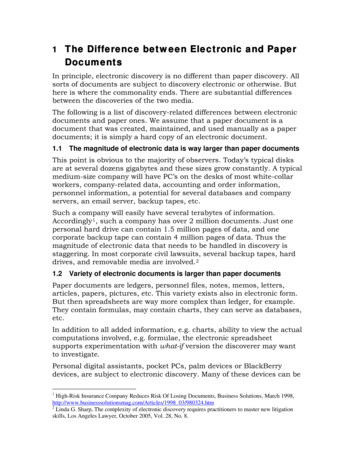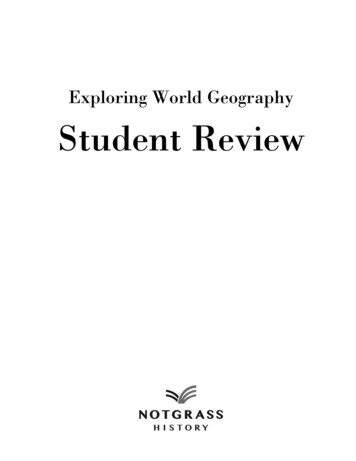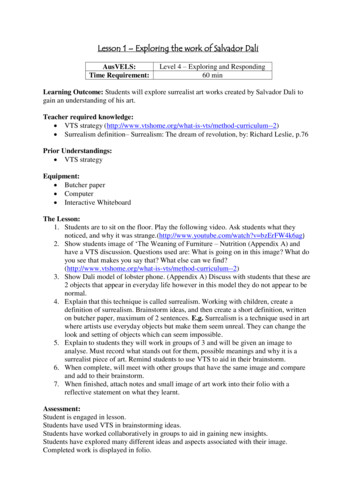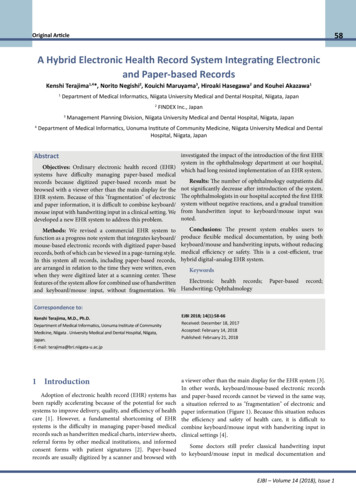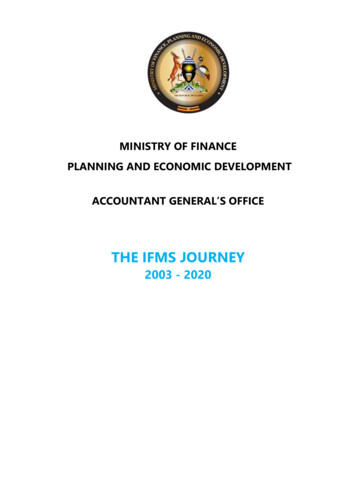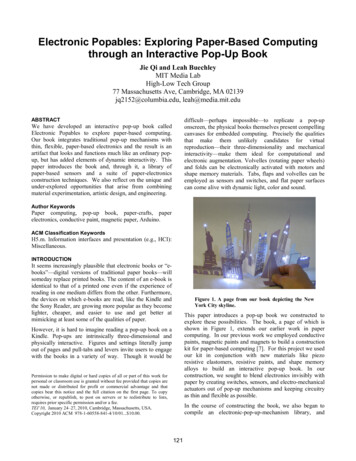
Transcription
Electronic Popables: Exploring Paper-Based Computingthrough an Interactive Pop-Up BookJie Qi and Leah BuechleyMIT Media LabHigh-Low Tech Group77 Massachusetts Ave, Cambridge, MA 02139jq2152@columbia.edu, leah@media.mit.eduABSTRACTdifficult—perhaps impossible—to replicate a pop-uponscreen, the physical books themselves present compellingcanvases for embedded computing. Precisely the qualitiesthat make them unlikely candidates for virtualreproduction—their three-dimensionality and mechanicalinteractivity—make them ideal for computational andelectronic augmentation. Volvelles (rotating paper wheels)and folds can be electronically activated with motors andshape memory materials. Tabs, flaps and volvelles can beemployed as sensors and switches, and flat paper surfacescan come alive with dynamic light, color and sound.We have developed an interactive pop-up book calledElectronic Popables to explore paper-based computing.Our book integrates traditional pop-up mechanisms withthin, flexible, paper-based electronics and the result is anartifact that looks and functions much like an ordinary popup, but has added elements of dynamic interactivity. Thispaper introduces the book and, through it, a library ofpaper-based sensors and a suite of paper-electronicsconstruction techniques. We also reflect on the unique andunder-explored opportunities that arise from combiningmaterial experimentation, artistic design, and engineering.Author KeywordsPaper computing, pop-up book, paper-crafts, paperelectronics, conductive paint, magnetic paper, Arduino.ACM Classification KeywordsH5.m. Information interfaces and presentation (e.g., HCI):Miscellaneous.INTRODUCTIONIt seems increasingly plausible that electronic books or “ebooks”—digital versions of traditional paper books—willsomeday replace printed books. The content of an e-book isidentical to that of a printed one even if the experience ofreading in one medium differs from the other. Furthermore,the devices on which e-books are read, like the Kindle andthe Sony Reader, are growing more popular as they becomelighter, cheaper, and easier to use and get better atmimicking at least some of the qualities of paper.Figure 1. A page from our book depicting the NewYork City skyline.This paper introduces a pop-up book we constructed toexplore these possibilities. The book, a page of which isshown in Figure 1, extends our earlier work in papercomputing. In our previous work we employed conductivepaints, magnetic paints and magnets to build a constructionkit for paper-based computing [7]. For this project we usedour kit in conjunction with new materials like piezoresistive elastomers, resistive paints, and shape memoryalloys to build an interactive pop-up book. In ourconstruction, we sought to blend electronics invisibly withpaper by creating switches, sensors, and electro-mechanicalactuators out of pop-up mechanisms and keeping circuitryas thin and flexible as possible.However, it is hard to imagine reading a pop-up book on aKindle. Pop-ups are intrinsically three-dimensional andphysically interactive. Figures and settings literally jumpout of pages and pull-tabs and levers invite users to engagewith the books in a variety of way. Though it would bePermission to make digital or hard copies of all or part of this work forpersonal or classroom use is granted without fee provided that copies arenot made or distributed for profit or commercial advantage and thatcopies bear this notice and the full citation on the first page. To copyotherwise, or republish, to post on servers or to redistribute to lists,requires prior specific permission and/or a fee.TEI’10, January 24–27, 2010, Cambridge, Massachusetts, USA.Copyright 2010 ACM 978-1-60558-841-4/10/01. 10.00.In the course of constructing the book, we also began tocompile an electronic-pop-up-mechanism library, and121
developed several techniques for combining electronics andpaper. The majority of this paper will walk the readerthrough our book and its corresponding library page bypage, but we will first examine a rich history of relatedwork.[23]. In the best of these projects, equal attention is paid topaper and computation. The materials compliment eachother and the system exploits the affordances of eachmedium.Our Popables project differs from most of these projects byfocusing on a stand-alone paper book. Almost all of theprevious work has treated paper as a user interfacecomponent. Though our book could function as a userinterface, it was designed to be an independent interactiveartifact. Furthermore, our project breaks new ground inexploring the integration of electronics and pop-upmechanisms and in explicitly focusing equal attention onfunctional and aesthetic design.RELATED WORK: PAPER AND COMPUTERSThe most familiar paper-computer relationship occursthrough printers. Printers have become so commonplace inour lives that they are taken for granted, but simple printerspresent rich, under-explored possibilities for integrations ofcomputation and paper. For example, the HyperGami andPop-up Workshop applications use printers to explorecomputational design for paper sculptures [11,13].HyperGami allows users to generate and manipulate threedimensional shapes by writing Scheme programs. Foldingnets for these shapes are generated by the software andprinted onto paper. Then, users can cut out the nets andfold them into colorful polyhedral sculptures [11].Similarly, Pop-up Workshop enables users to design pop-uppages that are then printed on color printers and assembledby hand [13].MATERIALS AND CONSTRUCTIONWe constructed our book by building individual interactivepop-up cards and then assembling them into a book. Wewere aided in our pop-up construction by examiningexisting books, like Sabuda’s beautiful Alice inWonderland [21], and following pop-up how-toinstructions. We found Barton’s The pop-up page engineerseries [4] and Birmingham’s Pop Up!: A Manual of PaperMechanisms [6] especially useful. We used three primarymaterials to build our paper-based circuits: copper tape,conductive fabric, and conductive paint.A different kind of ingenious printing—where machinereadable codes are printed onto paper—has given rise totechnologies like Anoto [1], in which a pen with a built-incamera uses a barely-perceptible dot pattern printed onto apage to capture its tip’s position. The Anoto Pen can thusrecord and store what someone has written and this data canbe downloaded to a computer to be saved, manipulated, oremployed by other software. Several interface researchershave exploited this type of technology to enable users toemploy drawing and writing in computationalenvironments. For example, in early work in this area,Johnson et al. used machine readable forms—like the formscommonly used for standardized tests—as “paper userinterfaces” [14]. More recently, Liao et al.’s PapierCraftsystem, which employs the Anoto, enables users to fluidlyedit and annotate paper documents and then upload thesemanipulations to companion digital pages [16]. Similarly,Tsandilas’ et al.’s Musink software, also Anoto based,enables music composers to capture and edit handwrittenscores [22].Copper tape is a highly conductive 100% copper materialwith an adhesive on one side. It can be cut with scissorsand attached to paper like traditional tape. To create twodimensional traces, straight lines of tape are soldered toeach other. The tape has the advantages of being flat,highly conductive—with a surface resistivity of .01 Ohmper square—and easy to solder to, but breaks on repeatedbending, and must be applied tape-like in linear sections. (Itis difficult to construct curving traces.)To get around some of these deficiencies, we also employeda tin and copper plated fabric called Zelt [12] in ourdesigns. To attach the fabric to our pages, we applied aheat-activated adhesive to one side of the fabric and thenironed fabric pieces onto paper (see [8] for moreinformation on this technique). Though not as conductiveas copper tape—with a surface resistivity of .1 Ohm persquare—the fabric can withstand repeated bending, isthinner and softer than the tape, and can be cut into curvingand large area traces.Another genre of related research involves combining paperwith a variety of hardware to build custom user-interfaces.For example, Mackay et al. developed a system thatemploys a PDA and WACOM tablet [17] to enablebiologists to record, evaluate, and enrich their handwrittennotes. Raffle et al. also used a WACOM tablet, along withcustom built hardware, in the Jabberstamp application,which lets children associate recorded audio with paperdrawings [19]. In a different but related vein, Back et al.constructed a paper book augmented with RFID tags andcapacitive sensors as part of an immersive museuminstallation called the Listen Reader [3], and in theBookisheet project Watanabe et al. attached bend sensorsand switches to paper to construct a novel user interfaceThe most suitable conductor for paper however isconductive paint. Conductive paint enables a designer topaint or sketch functioning circuitry just the way he wouldsketch or paint an electrical schematic or a decorativedrawing. What’s more, the paint is absorbed into the paperand thus becomes part of the paper artifact in a way that thetape and fabric do not. We used a water-soluble copperbased paint called CuPro-Cote [12] for this project. Similarmaterials that we experimented with (the silver and nickelprint materials from [12] for example) are solvent-basedand can be dangerous to employ without respirators, latex122
gloves, and other protective equipment. In contrast, CuProCote can be applied like a traditional latex paint. It doeshave drawbacks however. With a surface resistivity of 1Ohm per square, it cannot carry large amounts of currentwithout significant voltage drop, and, like other paints, itcracks, and therefore loses conductivity, on repeatedbending.backside and on others most of the circuitry wasincorporated into the decoration on the front. Most pagesinclude a combination of paper-based circuitry andtraditional electronics. To assemble our final book, weattached all of our individual cards together with blankpages separating the interactive pages to protect andinsulate their circuitry. To access the circuitry on the backsof the pages, the book can be extracted from its cover,unfolded, and “read” from the reverse side. Figure 3 showsimages of our completed book.In addition to the CuPro-Cote, we also made use of acarbon-based resistive paint called YShield [12], with asurface resistivity of 10 Ohms per square, to build paperbased resistors and potentiometers. Figure 2 shows theback of one of our pages that includes several of thesematerials.Figure 2. Left: the back of one of our pages thatincludes conductive fabric (grey), resistive paint(black), and copper tape (orange). Right: an LEDsoldered to a painted CuPro-Cote trace .We employed a variety of techniques to attach thesematerials to each other and to attach electronic elements toour circuitry. Copper tape and conductive fabric weresoldered together. To electrically connect a painted trace toanother material, we extended our painting onto the othermaterial. Electronic elements like Light Emitting Diodes(LEDs) were soldered directly to paint, fabric or tape.Figure 2, for example, shows an LED soldered to a paintedtrace.Figure 3. Top, left: the book, right: magneticelectronic modules stored on the first page. Bottom:the book, turned inside-out, showing circuitry on theback of the pages.LEDs, circuitry, and other components were embeddeddirectly into individual pages, but a power supply, acustom-made Arduino microcontroller [2], and a speakerare shared by all the pages. These shared components—elements of our construction kit for paper computing [7]—are small stand-alone circuit boards with magnets attachedto them. The magnets make physical and electricalconnections between the boards and ferrous surfaces. Toattach these magnetic boards to our book, we glued piecesof steel-impregnated-paper to each page. This “paper steel”keeps the magnetic components attached to the pages whileblending into the rest of the paper construction. When notbeing used by individual pages, the magnetic elements arestored on the first page of the book (see Figure 3).THE BOOK: ELECTRONIC POPABLESOur book consists of six pages, each with a different pop-uptheme, sensor mechanisms, and—in some cases— uniqueactuator mechanism. We now turn to an examination ofeach of our pages and construction techniques.Page One: Pink Flowers and SwitchesIn addition to the materials we have mentioned, we alsoused shape memory alloys, conductive thread, and piezoresistive elastomers. We will describe these materials in thenext section, when we describe their applications.In the first page we constructed we experimented withswitches made from pull-tab mechanisms. Pull-tabs cangenerate movement in pop-ups in an endless variety ofways. Our page, shown in Figure 4, employs threemechanisms that are activated by tabs: levers, slides, andpivots. The page has no computational elements and ispowered only by the magnetic battery. As each tab ispulled it closes or opens a switch, causing LEDs in the pageto turn on or off.Electronics were attached to both sides of our pages. Onsome pages the majority of the circuitry was hidden on thePulling the first tab (the lever) causes a flower petal to slideupward and the flower underneath it to light up. When a123
Page Two: Orange Ocean and Potentiometersuser pulls the second tab (the slide), a bee moves in awaving line down the page, blinking on and off as it travels.The third component is a series of flowers that all rotate(pivot) and glow when a tab is pulled.Having found several ways to turn pop-up elements intoswitches, we turned our attention to sensors. Our secondpage, shown in Figure 5 explored paper-basedpotentiometers. It uses sliding and rotational motion tocontrol the brightness of page-embedded LEDs. The leftside of the page uses a rotational potentiometer to actuatethree jellyfish: as the handle swings from left to right, thejellyfish dim and brighten. On the top right, sliding a tabmoves two fish down a resistor. As the fish move, theybecome dimmer. Finally, on the lower right, as a handleswings back and forth, two sets of lights on a piece of coralalternate in brightness.Figure 4. Top: the flower on the left is open and thebee is at the top of its track. Bottom: after pullingthe tabs, the flower is closed and the bee is at thebottom of its track, its light turned off. The battery isthe dark pink teardrop shape in the lower left handcorner of the page.To make a switch, a pull-tab is constructed out of a tube ofpaper with conductive fabric or paint applied to its interior,as shown in Figure 5. (All conductive material in ourdiagrams is shown in yellow.) An insert for the tubecontains two ends of an uncompleted circuit from the popup page. As the tube’s conductive fabric slides across theinsert it makes contact with the two ends and completes thecircuit.Figure 5. Top: with the wiper to the right thejellyfish lights are off. Bottom: with the wiper to theleft the lights are on. Similar changes can also beseen in the other elements.The potentiometers were created by painting a resistor ontoa page with resistive paint and then attaching a conductivewiper that moves across the resistor. In the rotatingpotentiometers, a diagram of which is shown in Figure 6,the resistors were painted onto steel impregnated paper andmagnets were attached to the wipers to ensure robustconnection between resistor and wiper at all times.Figure 5. A paper switch mechanism. Note:conductors are shown in yellow in this and allsubsequent diagrams.124
Almost all of the circuitry for this page is painted directlyon the top surface of the paper—very little is hidden fromview, as can be seen on close inspection of Figure 8. All ofthe painted lines lead back to the Arduino. At the jointsbetween the pop-up panels and the rest of the page wereinforced our circuits with conductive fabric, which—aswe mentioned earlier—can fold repeatedly withoutbreaking.Page Four: Yellow Solar System and PressureSensorsFigure 7. The rotator potentiometer mechanism.Resistive paint is shown in black and the magnet isshown in grey. The resistance between the wiper andthe ends of the painted resistor changes as the wipermoves back and forth.The yellow page is another non-computational page thatuses a piezo resistive elastomer—a material whoseresistance changes in response to compression—as apressure sensor [24]. When the page is opened, a sphericalslice-form that represents the sun pops out of the page. Bypressing on different planets on the flat part of the page, theuser activates assorted behaviors: when the user pressesPluto, the sun gradually lights up, growing brighter inresponse to increased pressure. Squeezing Uranus causesSaturn’s rings to glow. Pushing on the earth causes themoon to dim, and, finally, pressing on Mars triggers anembedded motor that makes Venus vibrate. Images of auser interacting with the page can be seen in Figure 9.Page Three: Blue Skies and Skin Galvanic ResponseSensorsThe blue page was the first page we built that incorporatedcomputation. It is controlled by the magnetic Arduinomodule and, in addition to page-mounted LEDs, it uses themagnetic speaker module. When the page is opened, adisplay of stars and clouds rises up out of the page as can beseen in Figure 8. When the Arduino is placed onto the pageand turned on, “Twinkle Twinkle Little Star” begins to playand LEDs flash in a pattern in sync with the music. Whenthe user touches both of the large grey stars on the page, thetempo of the music increases. The more pressure the userapplies to the stars, the faster the tempo becomes.Figure 8. Top: When a user touches both of the silverstars, the tempo of a song played by the pageincreases.This sensor, a skin galvanic response sensor, measures theconductivity of the user’s body. It is created by connectingone conductive surface to an input on the Arduino andanother conductive surface to ground. When the usertouches both surfaces, the Arduino detects how resistive theperson is. The harder the user pushes on the patches, thelower the resistance is between the two surfaces. (We donot include a diagram of this sensor because of itssimplicity.)Figure 9. A page with embedded pressure sensors.The bottom image shows the sun glowing when auser presses Pluto.The pressure sensors were all constructed by sewing theelastomer, called Zoflex [24], to the page with a silverplated conductive thread [12]. When a user squeezes thematerial it begins to conduct, connecting the twoconductive threads. Increased pressure results in increased125
When this page is opened, a cutout of the New York Cityskyline rises up from the book. The bend sensor is hiddeninside a flap that is shaped like a sailboat that lies on thepage. When this flap is lifted, the buildings light up in fourstages and the speaker plays four rising notes. The lowerstories light up first, then higher stories, until finally all ofthe lights come on.conductivity through the material. After the material wassewn to the page, an insulating fabric was glued over it tosecure the sensor. Finally a thick decorative paper, whichdistributes pressure evenly across the sensor, was glued ontop of the insulating fabric. A diagram of this sensor isshown in Figure 10.The buildings were laser cut so that windows, holes in thepaper, make up most of the facades and give the buildings alacy effect. Lights were placed in the holes so thatwindows appear to glow. To make traces on the buildings,the paper cutouts were carefully painted with conductivepaint.The bend sensor, a diagram of which is shown in Figure 12,was constructed by sandwiching a piece of Velostat [12], athin piezo resistive plastic, between two layers ofconductive fabric. (For more information on this bendsensor, see this tutorial by Hannah Perner-Wilson [18].)This sensor functions similarly to the pressure sensordescribed in the previous section. When a user bends thesensor, the velostat is compressed and its conductivityincreases, thus decreasing the resistance between the twoconductive layers.Figure 10. The pressure sensing mechanism. Theelastomer is shown in grey and the conductivethreads are shown in yellow. The resistance betweenthe two threads changes when pressure is applied tothe elastomer.Page Five: Purple NYC and Bend SensorsThe fifth page, shown in Figure 11, employs the magneticspeaker and Arduino, and a custom made bend sensor.Figure 12. A bend sensor. Velostat is shown in black.The resistance between the two conductors changeswhen the sensor is bent.Page Six: Green Venus Flytraps, Capacitive Sensors,and MovementOur final page, shown in Figure 13, employs the magneticArduino and an additional magnetic battery module. SixVenus flytraps spring up from the book when a user turns tothis page, and when someone touches the center of one ofthe leaves it closes around their finger.To achieve this affect, all of the leaves have springs madeout of shape memory alloy—a nickel titanium, or “nitinol”wire—embedded in them which allows them to fold openand closed. A spring contracts and closes its leaf when it isheated by an electrical current. A leaf reopens when thewire cools and the force of the paper pulls the spring openagain.Figure 11. A bend sensor (labeled with an arrow inthe top image) controls the lights in the skyscrapers.In the top image the sensor is flat and only thebottom-most lights are on. In the bottom image, thesailboat is fully erect, causing all of the lights toshine.126
CONCLUSION: MATERIALITY, FUNCTIONALITY,AND BEAUTYBy describing in detail the materials and techniques weemployed in our exploration, we hope to provide a usefulreference to others who are interested in exploring paperbased electronics. Perhaps most importantly however, wewant this paper to serve as an example of an under-utilizedand fruitful style of interaction design, one that integratesmaterial experimentation with an exploration of thefunctional and aesthetic affordances of computationalmedia.Materiality, functionality, and beauty are deeply related.When one builds a chair, for example, there are functionaland aesthetic implications to choosing a particular wood orupholstery fabric for its construction. Computation hasallowed us to escape from many of these physicalconstraints, and their accompanying design traditions.Computational media, in its intrinsic abstractness, gives usextraordinary power to decouple behavior from material.Thus a cell phone can sound like a bird, a trumpet, or apolice car; a computer can work like a sketchpad, a camera,or a library. This incredible power and flexibility haslimitations however, limitations that are reflected in the factthat the majority of computational devices are still hard,drab-colored boxes.Figure 13. Capacitive sensors trigger nitinol-drivenflytraps. Top: a user touches a sensor. Bottom: atrap in its open and contracted states.Integrating interaction design with an exploration ofphysical materials expands designers’ creative toolbox,enabling them to construct devices that look, feel, andfunction very differently from the boxes we have becomeaccustomed to. And, by explicitly acknowledging the dualimportance of aesthetics and function, designers can exploitthe full potential of all of their construction materials. Instriving for aesthetic affects, new functional and materialproperties are uncovered.Conversely, material andfunctional constraints give rise to new styles and ways ofseeing.Three leaves have capacitive touch sensors embedded inthem to detect user interaction. These sensors detect theamount of electrical charge present on conductive surfaces.Each sensor is composed of three layers: a ground layer, aninsulating layer, and a sensing layer, as is shown in Figure14. The sensing and ground layers can be constructed fromconductive paint, fabric, or any conductive sheet. Thesensing layer is attached directly to one input pin (pinA) onthe microcontroller and to another pin (pinB) on themicrocontroller via a high value ( 10M Ohm) resistor. Themicrocontroller alternately drives pinB high and low, whilemonitoring the time it takes for pinA to “follow” this signal.The follow time will change when a user touches thesensing surface, thus enabling the microcontroller to detectinteraction. For more information on this and othercapacitive sensing techniques see Baxter’s excellentreference [5].In the case of the pop-up book we began with three parallelgoals: a) to build a beautiful and engaging popup book, b)to explore the integration of paper and electronics usingreadily available off-the-shelf materials, and c) to explorenew interaction techniques arising from these combinations.Our aesthetic requirements forced us to confrontengineering challenges we may not have encounteredotherwise. We were forced to employ thin and flexiblecomponents that could either be hidden or integrated intopage decorations. These constraints in turn led us todiscover new material affordances and interactionpossibilities. Among other things, we discovered thatconductive paints can be used in an intuitive, gesturalfashion to construct electrical devices that beautifullyillustrate their own function, and we are currently exploringhow these materials might be employed in educationalsettings.Figure 14. A diagram of the capacitive sensor.127
13.Hendrix, S. and Eisenberg, M. (2005). Computerassisted pop-up design for Children: ComputationallyEnriched Paper Engineering. In Proceedings of IASTEDIntl. Conf. On Computerss and Advanced Technology inEducation.We believe that consciously addressing materiality,functionality, and beauty enabled us to expand thelandscape of interaction design to create an artifact thatconfounds traditional stereotypes about the look and feel oftechnology.14.Johnson, W., Jellinek, H., Klotz, L, Rao, R, and Card, S.(1993). Bridging the paper and electronic worlds: Thepaper user interface. In Proceedings of CHI, pp. 507512.ACKNOWLEDGMENTSThanks to TungShen Chew and Mike Eisenberg for theircontributions and conversation. This work was funded inpart by the National Science Foundation’s CRA-W DREUprogram and the MIT Media Lab consortium.15.Kindle. www.amazon.com/kindle.2. Arduino. www.arduino.cc16.Liao, C., Guimbretiere, Hinckley, K., and Hollan, J.(2008). PapierCraft: A gesture based command-systemfor interactive paper. ACM Transactions on ComputerHuman Interaction. 14(4):18, pp.1-27.3. Back, M., Cohen, J., Gold, R., Harrison, S., Minneman,S. (2001). Listen Reader: An Electronically AugmentedPaper-Based Book. In Proceedings of CHI, pp. 23-29.17.Mackay, W. et al. (2002) The Missing Link:Augmenting Biology Laboratory Notebooks. InProceedings of UIST 2002, pp. 41-50.4. Barton, C. (2007 and 2008). The pop-up page engineer:how to make pop-ups step by step, volumes 1 and 2,Popular Kinetics Press, NY, NY.18.Perner-Wilson, H. How to make a bend sensor tutorial.http://www.kobakant.at/DIY/?p 20.REFERENCES1. Anoto. www.anoto.com.19.Raffle, H., Vaucelle, C., Wang, R., and Ishii, H. (2007).Jabberstamp: Embedding sound and voice in traditionaldrawings. In Proceedings of Interaction Design andChildren (IDC), pp. 137-144.5. Baxter, L.K. (1996) Capacitive Sensors: Design andApplications, Wiley-IEEE Press.6. Birmingham, D. (1999). Pop Up!: A Manual of PaperMechanisms, Tarquin, Norfolk, UK.20.Rogers, Y. (2006). Moving on from Weiser's Vision ofCalm Computing: Engaging UbiComp Experiences. InProceedings of the International Conference onUbiquitous Computing (Ubicomp), Orange County, CA,Septermber, 2006.7. Buechley, L., Hendrix, S., and Eisenberg, M. (2009).Paper, Paint, and Programs: First Steps Toward theComputational Sketchbook. In Proceedings of Tangibleand Embedded Interaction (TEI), pp. 9-12.21.Sabuda, R. (2003). Alice and Wonderland, Little Simon,NY, NY.8. Buechley, L. and Eisenberg, M. (2009) Fabric PCBs,Electronic Sequins, and Socket Buttons: Techniques forE-textile Craft. Journal of Personal and UbiquitousComputing, 13(2), pp 133-150.22.Tsandilas, T., Letondal, C., and Mackay, W. (2009).Musink: Composing music through augmented drawing.In Proceedings of CHI, pp. 819-828.9. Ditlea, S. (2001). The Electronic Paper Chase. ScientificAmerican, Nov. 2001, pp. 50-55.23.Watanabe, J., Mochizuki, A., and Horry, Y. (2008).Bookisheet: Bendable device for browsing content usingthe methaphor of leafing through the pages. InProceedings of UbiComp, pp. 360-369.10.E-ink. www.eink.com11.Eisenberg, M. and Nishioka, A. (1997). Orihedra:Mathematical Sculptures in Paper. International Journalof Computers for Mathematical Learning, 1:225-261.24.Zoflex. agnetic Field Shielding Paints and Fabrics.www.lessemf.com128
through an Interactive Pop-Up Book Jie Qi and Leah Buechley MIT Media Lab High-Low Tech Group 77 Massachusetts Ave, Cambridge, MA 02139 jq2152@columbia.edu, leah@media.mit.edu ABSTRACT We have developed an interactive pop-up book called Electronic Popables to explore paper-based computing. Our book integrates traditional pop-up mechanisms with
